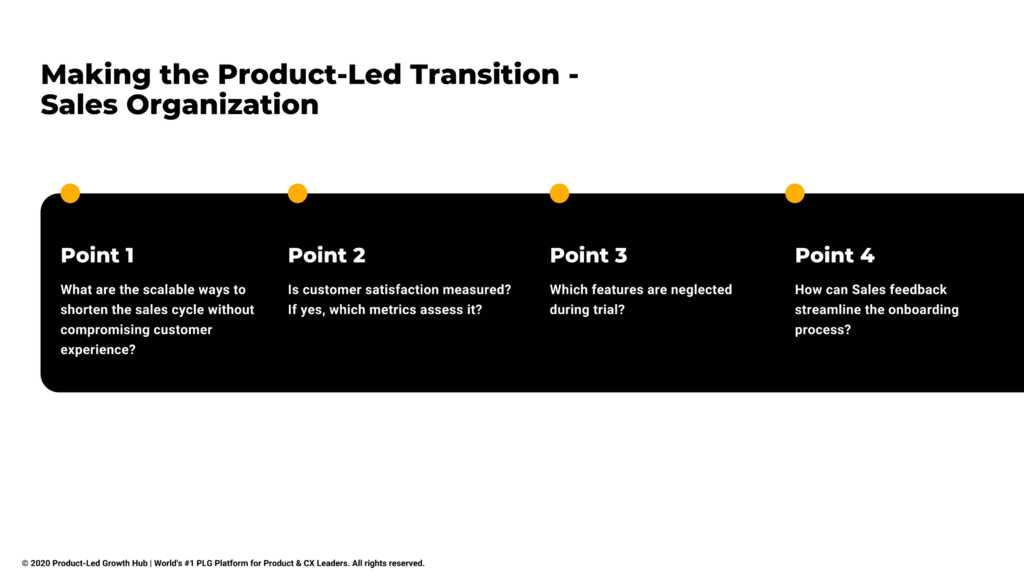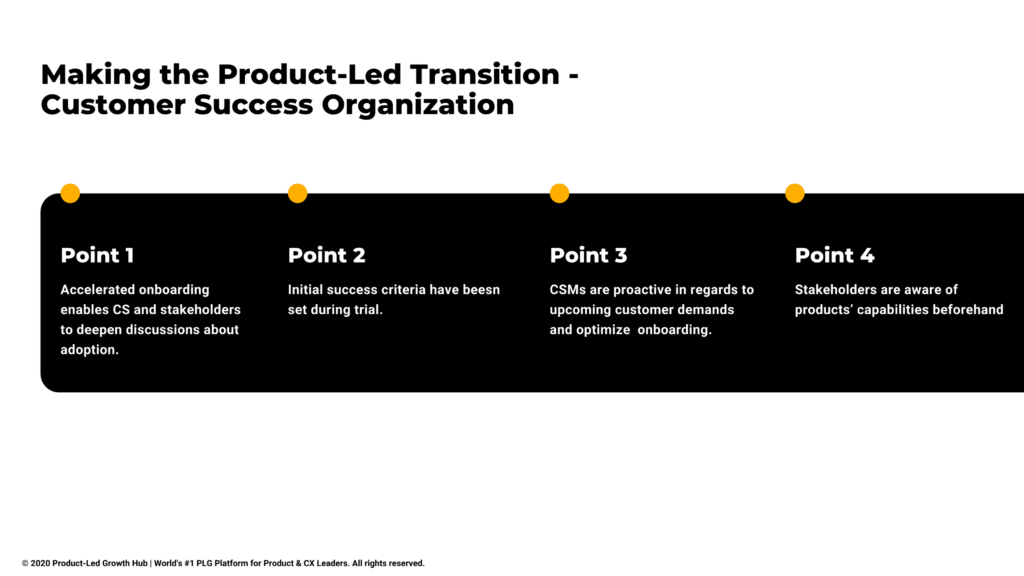Introduction
The disruptive SaaS ecosystem is overtaking the digital world. We live in an era where almost everything can be managed from the comfort of our screens. Consumerization further embraces this notion. It encourages the delivery of flawless product experiences in B2B too. While the product becomes the main growth lever. The emerging Product-Led GTM practices only support that direction. But, not without bringing more complexity to existing internal procedures. Product management is now in the foreground. It addresses every step of the customer journey and optimizes roadmaps’ inputs.
Product data can pinpoint roadblocks and product delights. Those changes, force internal teams to adopt a more quantitative, customer-centric approach. Data now become the single source of truth across an entire organization. That shift makes the greatest challenge following a Product-Led GTM strategy the repositioning of customer experience itself.
The Multifaceted Customer Experience
What is Customer Experience?
Customer experience is the customer’s perception based on all interactions between him and a company. In the digital world, however, where the channels of communication are going far beyond the traditional buyer-seller process, this term is very narrow. In this instance, we are going to agree with Gainsight that Customer experience (CX) is a customer’s perception of a company, brand, or product, based on all touchpoints, interactions, and the plethora of social mediums, ads, social communities shape customers’ expectations radically. Even before he considers trying a service. In fact, McKinsey showed that B2B customers use six channels during the decision-making process. At the same time, 65% of them will end up being frustrated by inconsistencies across these channels. engagements.
Why is Customer Experience is important for your SaaS business?
Delivering a great customer experience is imperative. The more optimized it is, the more customers will keep coming back to your product. Stellar customer experiences reduce churn while broken ones result in friction and a never-ending customer experience gap.
What Defines Customer Experience?
The answer to this question is multifaceted. There are many paths organizations can take when striving to increase customer satisfaction. Depending on the lengths each one of them is willing to go, customer experience can either become the holy grail leading to hypergrowth or the sole denominator making an organization go extinct.
Common questions customer-facing teams may ask themselves prior to purchase can be:
- What is the context behind the customer’s use case? The role, use case, existing workflow, business goals
- What does he want to buy? Purchase history, proficiency level (newbie or proficient user)
- Why does he want to buy? Need that has to be fulfilled (new or existing), buying journey so far, motivations
- Where and how she prefers to buy? Preferred platforms, demographics, channels & touchpoints of engagement.
- How does the customer’s offering affect the purchase decision? Customer’s offering characteristics & alignment with solutions’ offering.
- Who will the purchase affect? Number of departments, end-users & key stakeholders
The Rise of Product Experience
Although all these questions profile prospects’ intent, in the case of SaaS there is a parameter we cannot neglect. The “power of choice” hyper-competition provides. By competition here, we don’t refer to pricing or more advanced features. Nowadays, those things can be copied and iterated within a blink of an eye. A stellar product experience on the other hand, not so much.
The rise of IT consumerization shifts customers’ standards. It makes them consider product experience next to the personal relationship they may create with any vendor. This tendency doesn’t go away, no matter the size of the deal. The oversaturation of s/w services and the rise of technology make stellar product experience the one feature a product needs to deliver. This counts both for buyers and end-users, as contrary to people’s beliefs the dynamic of the latter is equally important.
Try not to forget. A traditional sales model may be characterized as Top-down, but inside customers’ organization, it is inversely proportional. End users are the one barrier that reaffirms the internal buy-in. Something that makes the delivery of product experience paramount to organizations’ long-term prosperity. If we add on that inconsistency in GTM practices, limited experimentation, and infinite handholding we have the rise of an era, where a whole industry needs to reinforce the power of the “machines” in order to upgrade the human-assisted performance. It may sound counter-intuitive, but it’s true. When adopting a Product-Led GTM strategy, organizations should go out of their ways. They need to discourage ongoing hand-holding, double down on products’ superpowers, and break up silos.
Following that logic, typical dilemmas internal teams may encounter are:
- What affects customer experience product or human-assisted activations? Or maybe is it a composite of both?
- How can personal outreach be replaced by product engagements without downgrading customer experience?
So, does customer experience have as a sole denominator, product experience outcomes? No. This, not an either-or situation. When anticipating the product as a growth lever customer experience can be reinforced by its deliverables. But only when they are monitored and evaluated right, they can deepen the buyer-vendor relationship.
Who Owns Customer Experience?
The short answer to this question can be The departments responsible for the sum of touchpoints and product delivery. That realization sums up activations delivered by many internal organizations. Sales, Marketing, Customer Success, and Product Management being some of them. Their involvement in the customer journey is subject to the product offering and customers’ needs.
1) The Product Imperative
As a rule of thumb, organizations in favor of a Top-down sales model deliver more complex products. Products that are usually followed by equally complex sales cycles. The same stands for customers’ needs. The more demanding and complicated customers’ existing workflows are the more complex the solution’s deployment. Those two factors are for sure not exhaustive. But they can set the basis to get the conversation started.
Products’ Complexity
The table’s two main axes are the customers’ needs and products’ complexity. While the two top options favor a Top-down approach and the two in the bottom a Bottoms-up. So, there is a case sales delivery to be no-touch and as its complexity grows, the organization inclines towards a traditional sales model. Alternatively, the opposite can happen. A product may target high-tier customer segments and then alter its offering and move down market. The only thing we can take for granted is that Sales’ activations get less automated and scalable. While at the same time the product offering gets more sophisticated.
The third wave of SaaS products alters this mindset and revolutionizes how people try, buy, and use the software. The buying process does not need anymore a direct interaction with sales. Buyers can now access product-related content through a variety of channels and devices. They can also assess what to expect from any solution before even signing up for a trial. As a matter of fact, two-thirds to 90% of the buyer’s journey can now be completed before even engaging with a salesperson.
The challenge for any organization at this point is not only to reflect on customers’ needs. Organizations need to also sustain those processes across an array of devices and channels. Without neglecting to deliver a stunning product experience at the same time.
2) High Trajectory Customers
High trajectory customers’ needs, go beyond educating key stakeholders and users. In this instance, a systemic process enabling customers to grow and organizations to cope with many requests need to be in order. Internal teams acknowledge that and develop more structured workflows at work. By default, the involvement of the human element is increased throughout the customer lifecycle. Not by choice. Only because internal teams need to sustain alignment with customers’ desired business outcomes. And because this is the only way to empower a bond between the two parties.
From the customers’ side, this mentality is inevitable to be reinforced. Having many end-users and departments that need to be in perfect sync, makes it inevitable for them to rely on human-assisted activations. That doesn’t necessarily mean that buyers don’t favor scalable practices. But, once they encounter a heavy administrative part, they will seek help from CSMs who know the use case next to automation. This is how they secure, they are getting the most out of their investment.
The Product-Led Shift
The fact that each product engagement can now be mapped and evaluated gives each department a different perspective on how its deliverables affect customer experience. This shift affects the traditional sales model too. Sales & Customer Success can now insert measurable product measurements in their evaluations. This fact alone brings Product Management into the discussion. On the downside, the SaaS industry has still some miles to walk until it harmonizes each team’s inputs throughout the customer journey. In our recent research Customer Success (76%) and Sales (69%) still, have the majority of ownership. While Product Management (38%) and Marketing (23%) come last.
But are only those departments accountable? Assuming an enterprise organization is served, Professional Services may also be part of the equation. Similarly, top-level management holds the reins of any final decision that needs to be taken. So, who owns customer experience after all?
While it’s obvious that ownership is dispersed, the discussion does not seem to slow down. As long as there are no clear lines distinguishing roles and responsibilities, businesses will struggle to have consistency across the customer journey.
3) Self Serve customers
Self-serve customers, represent the other side of the same coin. Both parties here need to shorten Time to Value and increase conversions. So far, Marketing was responsible for acquiring and nurturing customers. But now, this is changing. The emerging Product Management practices put products’ deliverables in the center of attention. They align those deliverables with customers’ ongoing growth. Something that may have lowered Marketing’s prevalence but for sure has not taken it out of the equation.
Self-Serve Vs. Human Assisted Activations
But what about the human element? In a no-touch approach, the product is the growth lever. Does this fact annihilate the importance and role of customer-facing teams? No, it does not. In fact, the opposite happens. The product is in the epicenter holding the reins of customer experience. And this is viable when capitalizing on the lessons learned from human-assisted activations.
This is the point where product experience becomes synonymous to customer experience. How? By delivering a more humane, tailored to users’ needs approach. Product Management needs to insert those learnings into the product itself and reduce customer-facing teams’ involvement.
That realization, however, may still be far from reality. In fact, our research showed that Product Management (81%) and Marketing (77%) may be involved. But, Customer Success (68%) and Sales (40%) outreach is still in order.
It is evident that Self-Serve adopters strive to balance the involvement of Sales and Customer Success organizations’ to and embrace activation and retention rates. Products’ complexity and limited investment (5%) in tailored onboarding flows reinforce this outcome. Our research results make it obvious. Even on a Self Serve approach, customer experience is paramount to human-assisted activations.
Making the Transition
Product-Led practices make it clear. Internal organizations have to shift their mentality and follow a product-centric approach. An approach that will become the extension of customers’ needs. The analysis below is an attempt to map those changes on a higher level.
Marketing Organization
Previously, marketing achieved growth by increasing acquisition levels. But without being able to embrace retention. As a result, customer journeys did not focus on product features and users’ needs. Something that downgraded customer experience, increased negative WOM and skyrocketed churn levels. Social mediums, advanced product content, and increasing competition shifted customers’ mindset. They made them more demanding in regards to product experience. Product-Led Marketing teams double down on the benefits and insights product experience provides. They deliver content tailored to users’ needs, by segmenting the use case, role, and context of usage. The Marketing organization, always reliant on prospects’ online data finally capitalizes on product insights too.
On every stage of the customer journey:
- Marketers are aware of activation points along with engagement and conversion levels. Following that logic, they capitalize on those insights to produce marketing & product content (in and out of the app).
- Silos abandonment, enables Marketing to deepen its roots in the customer journey. When cooperating with internal teams, Marketing is able to make retention its North Star metric. Simply by aligning internal feedback and pursuing ways to further educate and embrace advocacy.
- Despite the rise of multichannel touchpoints Marketing market positioning is sustainable. This is viable by investing in those mediums attracting more PQLs.
- Conversions are not the scope but the outcome of marketing activations. WOM, content delights, and product education are the main KPIs evaluating marketing practices.
Further Considerations:
- Which are the most critical points for users throughout the customer journey?
- How does positioning differentiates per medium?
- What learnings derived from product engagements and customer-facing teams’ activations can find their way into marketing deliverables?
- Does content “speak” users’ language per use case /role? Or does it need to include different keywords and expressions? (aka how tech-savvy users are?)
Sales Organization
Even nowadays, the Sales organization reaches out relying on metrics related to prospects’ online behavior and sign-ups. The customer wouldn’t taste the product before the deal was sealed and had a high-level idea of how it was affecting the existing workflow. Finally, ignorance of in-app engagements effectiveness, even when a POC was in order, increased CAC and reduced ROI. Now, Sales teams break the shackles of product demos and become part of the onboarding process. This fact alone affects customer experience and makes Sales accountable for initial adoption.
This fact alone implies that:
- Sales enable customers to realize initial value sooner in the customer journey.
- Based on the effects of data-driven engagement delivery, airtime conversation for product capabilities is eliminated. So, both parties can focus more on whether there is an actual fit or not. Something that gives Sales teams a consultative approach, drives CAC down and shortens the sales cycle.
- Sales can streamline the onboarding process by passing feedback to Product Management.
- Being owners of both trial data and business acquisition metrics Sales are able to deliver better projections on upcoming ROI.
- The onboarded team(s) can act later on as the product’s evangelist across customers’ organizations. That eases the burden of Customer Success which concludes the onboarding process. Customer-facing teams can now deal with the human hurdle. One of the main barriers towards successful adoption. At the same time, they achieve the internal buy-in sooner.
Consideration following product experience assessment:
- What are the scalable ways to shorten the sales cycle without compromising customer experience?
- Is customer satisfaction measured? If yes, which metrics assess live and scalable touchpoints?
- Which features are neglected during trial? Which features are used extensively by the various teams and why?
- How can the Sales organization feedback streamline the onboarding process?
- To what degree can Sales harmonize scalable and human-assisted interactions?

Customer Success Organization
A traditional Customer Success onboarding starts with understanding customers’ workflow and where the product fits in it. Next, related milestones leading to success and associated high-touch techniques are set. Unlike the self-serve approach, where the customer is autonomous, in a human-assisted one high-tech activations follow the high touch ones. When serving high-trajectory customers, having human-assisted activations delivering a custom treatment is more of a priority call. Customers are ingrained into complex procedures and do not fit into specific buckets. It is essentially the survival of the fittest. Organizations try, not to cross this fine thin line between delivering scalable automated results and a fair amount of custom practices that reinforce customer experience.
On a Product-Led GTM approach Customer Success remains the customer’s gatekeeper. But this time its actions are reinforced with the feedback provided by any department involved in product delivery. Customer health score takes a product-driven approach. It considers in-product activations in conjunction with existing business KPIs.
Additional shifts in Customer Success activations can be:
- The accelerated onboarding process enables both CS and stakeholders to move forward and deepen discussions about adoption and deployment.
- Customer Success Managers, move the conversation one step forward as Sales have set the initial success criteria during trial.
- CSMs know beforehand if there were discrepancies during the trial. That makes them proactive in regards to upcoming customer demands and optimize the onboarding process.
- Customer feedback is narrowed down in regards to the initial behavior the onboarded team(s) demonstrated. Also, buyers have already a high-level estimation of the onboarding process’s critical steps.
- Stakeholders are aware of products’ capabilities and able to pinpoint how the product matches their use case.
When evaluating customer experience:
- How much was the onboarding process accelerated per department/use case? Have Sales encountered barriers to entry?
- Which success criteria should be established?
- What could have been evaluated better during the customer’s trial?
- The lessons learned from the preliminary customer (passive & active) feedback.

Product Management Organization
Until very recently, gut feelings and isolation from the customer journey were describing Product Management involvement. Product Managers were launching features without considering product metrics. They were evaluating deliverables on whether a release was made on time. At the same time, they overlooked the positive or negative effects their development might have on customers’ growth.
With Product-Led on the rise, the need for customer-centric product experiences has become paramount. Product Management’s prevalence is now imperative throughout the customer lifecycle. The evaluation of customer feedback via the product itself embraced Product Managers’ role and influence across an organization. Now, they have to design products that deepen customer usage. Product Management’s alignment with customer-facing teams is also vital in order to inject their learnings into the onboarding flows.
Concerns following Product Managers:
- Product Management’s level of involvement in every stage of the customer journey.
- How can Product Management help product experience become an intentional effort across an organization?
- The creation of stellar product experiences that accelerate users’ proficiency. Always by considering any form of feedback received (active & passive).
- In what way product engagements can replicate the touchpoints customer-facing teams provide? Even more, how can they lead users to initial and true value?
- Can onboarding flows reflect on users’ roles & proficiency levels?
- What product metrics need to be established to evaluate workflows. Always by focusing on users’ roles and stage of the customer lifecycle.
- The consistency of product developments with products’ vision.
When evaluating customer experience:
- Where product activations upgrade or downgrade customer experience?
- Is product design intuitive and how does it affect time to value?
- Are onboarding flows targeted and delivered per role/use case?
- How much does user proficiency increase per-flow?
- Which non-product metrics complement onboarding flows’ results?
- The KPIs reinforce each stage of the customer lifecycle.
Conclusion
The transition of customer experience from human-assisted activations to the product itself is not an easy task. Internal teams cannot get there overnight, and neither should they. Putting the product into the center of attention means one thing. That all processes must focus on how the multiple touchpoints embrace product capabilities. When transitioning to a Product-Led GTM model your success or failure will be subject to one thing. How your practices align across the various channels while sustaining your value proposition.
No matter your executive role inside an organization, consider:
- Assess your knowledge, skills, and activations’ effectiveness throughout the customer lifecycle.
- Revise your practices and create a feedback loop with teams affecting product delivery.
- Develop a common set of metrics each team can use to assess product experience. Then see how they can supplement business and marketing KPIs.
- Evolve your practices, towards a customer-centric approach. Make no mistake, this is a work in progress.





